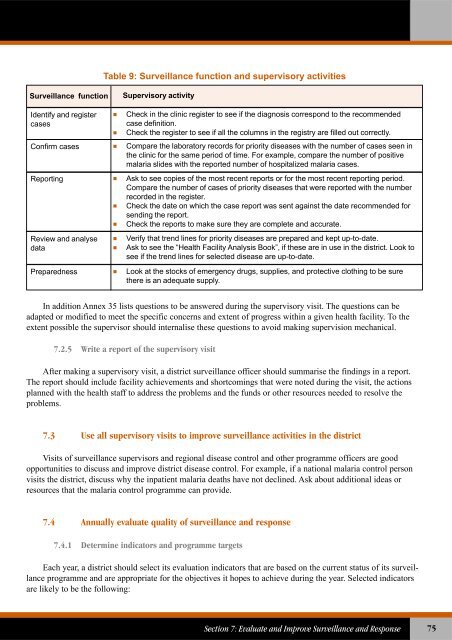Technical Guidelines for Integrated Disease Surveillance ... - PHRplus
Technical Guidelines for Integrated Disease Surveillance ... - PHRplus
Technical Guidelines for Integrated Disease Surveillance ... - PHRplus
You also want an ePaper? Increase the reach of your titles
YUMPU automatically turns print PDFs into web optimized ePapers that Google loves.
Table 9: <strong>Surveillance</strong> function and supervisory activities<strong>Surveillance</strong> functionSupervisory activityIdentify and registercasesCheck in the clinic register to see if the diagnosis correspond to the recommendedcase definition.Check the register to see if all the columns in the registry are filled out correctly.Confirm cases Compare the laboratory records <strong>for</strong> priority diseases with the number of cases seen inthe clinic <strong>for</strong> the same period of time. For example, compare the number of positivemalaria slides with the reported number of hospitalized malaria cases.Reporting Ask to see copies of the most recent reports or <strong>for</strong> the most recent reporting period.Compare the number of cases of priority diseases that were reported with the numberrecorded in the register. Check the date on which the case report was sent against the date recommended <strong>for</strong>sending the report.Check the reports to make sure they are complete and accurate.Review and analysedataVerify that trend lines <strong>for</strong> priority diseases are prepared and kept up-to-date.Ask to see the “Health Facility Analysis Book”, if these are in use in the district. Look tosee if the trend lines <strong>for</strong> selected disease are up-to-date.Preparedness Look at the stocks of emergency drugs, supplies, and protective clothing to be surethere is an adequate supply.In addition Annex 35 lists questions to be answered during the supervisory visit. The questions can beadapted or modified to meet the specific concerns and extent of progress within a given health facility. To theextent possible the supervisor should internalise these questions to avoid making supervision mechanical.7.2.5 Write a report of the supervisory visitAfter making a supervisory visit, a district surveillance officer should summarise the findings in a report.The report should include facility achievements and shortcomings that were noted during the visit, the actionsplanned with the health staff to address the problems and the funds or other resources needed to resolve theproblems.7.3 Use all supervisory visits to improve surveillance activities in the districtVisits of surveillance supervisors and regional disease control and other programme officers are goodopportunities to discuss and improve district disease control. For example, if a national malaria control personvisits the district, discuss why the inpatient malaria deaths have not declined. Ask about additional ideas orresources that the malaria control programme can provide.7.4 Annually evaluate quality of surveillance and response7.4.1 Determine indicators and programme targetsEach year, a district should select its evaluation indicators that are based on the current status of its surveillanceprogramme and are appropriate <strong>for</strong> the objectives it hopes to achieve during the year. Selected indicatorsare likely to be the following:Section 7: Evaluate and Improve <strong>Surveillance</strong> and Response75















